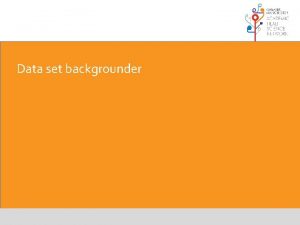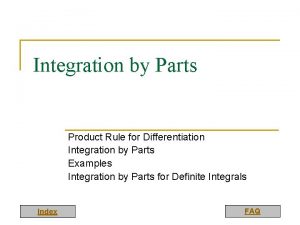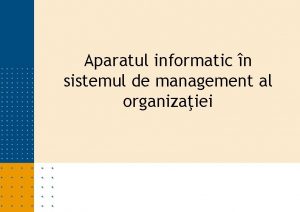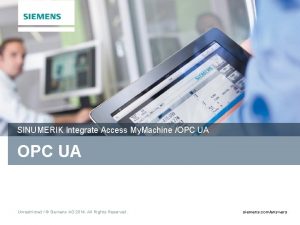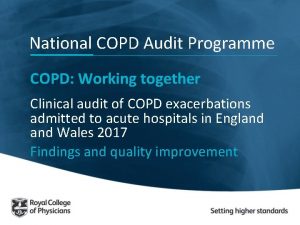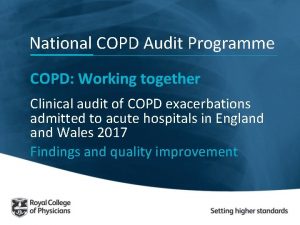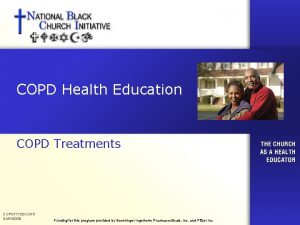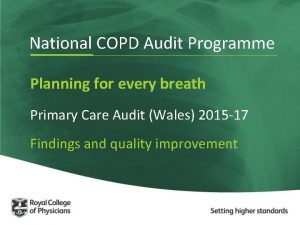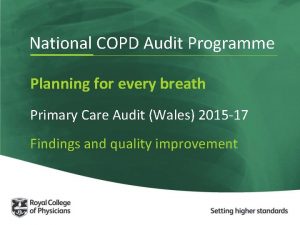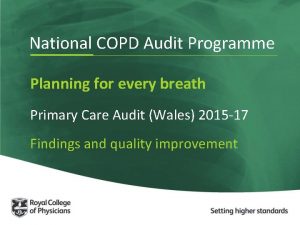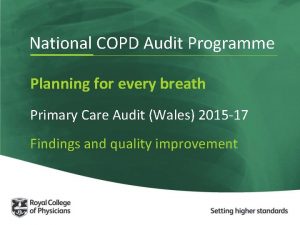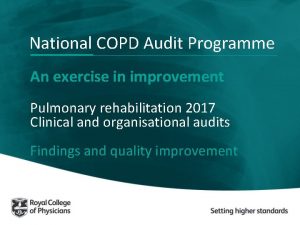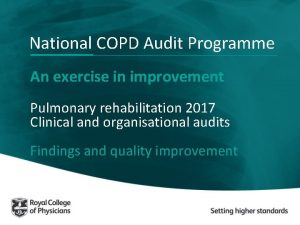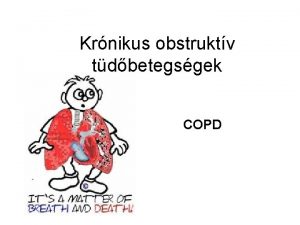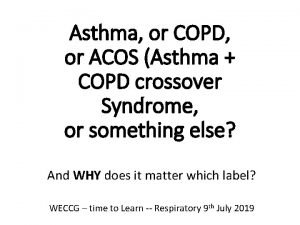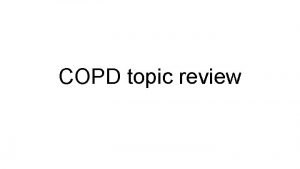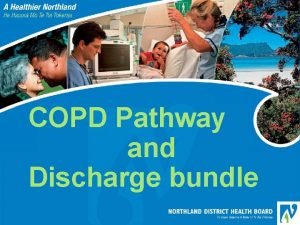National COPD Audit Programme COPD Time to integrate




















- Slides: 20

National COPD Audit Programme COPD: Time to integrate care Resources and organisation of care in hospitals in England Wales 2017 Findings and quality improvement

The audit programme partnership Working in strategic partnership: Supported by: Commissioned by:

Key findings and recommendations

Recruitment Audit participation All secondary care hospitals that admit patients with acute exacerbations of COPD (AECOPD) were invited to participate. Data collection began on 3 April, and closed on 30 June 2017. 197 Eligible hospitals 190 Hospitals participated Staff shortages were cited as the main reason for non participation.

Admissions, staffing levels, general organisation of care Admissions 2017 2014 13, 335 17, 584 General medical adult emergency admissions 2014 2, 433 2017 3, 191 2017 2014 609 570 Respiratory emergency admissions COPD admissions Staffing and general organisation of care 2014 2017 Respiratory team staffing unchanged since 2014 63% 88% 2017 54% Hospital provided Smoking cessation services On-site provision of palliative care services 2017 97%

Organisation of acute respiratory care Respiratory review The provision of new-patient ward rounds by senior decision makers (ST 3 or above) from the respiratory team has improved, but remains suboptimal outside of respiratory wards: 92% 85% 8% 14% 27% 29% 34% 49% On respiratory wards: increased to 92% in 2017 from 85% in 2014. Only 27% operate 7 days per week. 41% On medical admission units: increased to 49% in 2017 from 41% in 2014. Only 14% operate 7 days per week. On other wards: increased to 34% in 2017 from 29% in 2014. Only 8% operate 7 days per week.

Managing respiratory failure Non invasive ventilation (NIV) NIV training programmes (95%) are in near-universal use. This has improved from 90% reported in the 2014 audit. Emergency oxygen therapy 94% of hospitals have an oxygen policy in place. This has reduced from 95% reported in the 2014 audit. NIV monitoring charts (90%) are used widely. * 88% of hospitals have a named clinical lead for NIV service, in line with NCEPOD recommendations. This remains the same since the 2014 audit. 30% still have no training programme in place. This has improved from 32% reported in the 2014 audit. *This was not in the dataset for the 2014 audit hence no comparative data available.

Integrating care across primary and secondary sectors Integrated care 2017 2014 88% 77% 2014 38% Use of COPD discharge care bundles has increased to 88% in 2017 from 77% in 2014. 2017 2014 2017 88% 82% 46% The availability of PR within 4 weeks of discharge has increased to 46% in 2017 from 38% in 2014. Access to early/assisted COPD discharge teams has increased to 88% in 2017 from 82% in 2014. Weekdays 99 -100% Weekends 43% There is a contrast between access to integrated services from 99 -100% on weekdays compared to 43% at weekends. 2014 43% 2017 50% The facility for hospitals to provide home NIV has increased to 50% in 2017 from 43% in 2014.

Quality improvement (QI) 2014 audit recommended 9 key actions for teams to improve the quality of their care* 1 8% of hospitals achieved key action 1: All patients with COPD exacerbation who remain in hospital should be managed on a respiratory ward. 2 32% of hospitals achieved key action 2: All patients with COPD exacerbation who remain in hospital should receive a specialist respiratory opinion within 24 hours. 3 57% of hospitals achieved key action 3: Respiratory wards should be staffed to run at least 1 Level 2 bed where NIV can be administered, commensurate on demand the size of hospital. 4 64% of hospitals achieved key action 4: ICU outreach services should be available 24 hours, 7 days a week. 5 32% of hospitals achieved key action 5: All hospitals should have a fully funded and resourced smoking cessation programme delivered by dedicated smoking cessation practitioners. *The figures on this slide report how teams have met the recommendations set in 2014.

Quality improvement (QI) 2014 audit recommended 9 key actions for teams to improve the quality of their care* 6 47% of hospitals achieved key action 6: All hospitals should make spirometry results accessible from every computer desktop via their IT department’s browser system/intranet. 7 21% of hospitals achieved key action 7: There should be a data sharing agreement between hospital and primary care IT ensuring general practice spirometry data are universally available. 8 42% of hospitals achieved key action 8: Each acute hospital or trust should nominate a respiratory clinical lead for discharge care and integrating services. 9 32% of hospitals achieved key action 9: Hospitals should develop an improvement plan based upon recommendations within the national and their site-specific report. *The figures on this slide report how teams have met the recommendations set in 2014.

Key recommendations For providers across the sectors For commissioners / STPs • Develop achievable QI projects that aim to improve patient access to services, thereby possibly reducing the risk of avoidable admission. E. g. • Ensure there is an agreed COPD pathway that links discharge processes to admission avoidance strategies, as well as to evolving community-based frailty and social care services. Improving on the proportion of current smokers receiving smoking cessation pharmacotherapy • Review respiratory bed allocation, in light of the audit showing that most COPD patients are not being cared for by respiratory teams. • Work to develop a 7 -day, cross sector COPD service. Look at the existing resource and consider developing a business case to increase the team. • Ensure that within this pathway, pulmonary rehabilitation is available to all appropriate patients, including early post-discharge.

So, what happens next…?

Quality improvement (QI) Using quality improvement methodology to plan a change (SMART) Look for areas where you can realistically make improvements. Decide on an aim, this should be SMART. Build a team and understand your stakeholders. Meet with your team regularly to performance manage yourselves, and have clear responsibilities. S M A R Plan how you will achieve your aim. T • Specific • Measurable • Achievable • Realistic • Time bound

Quality improvement (QI) Defining your overall aim (driver diagrams) To decide what to start on for your overall improvement aim, you may find it helpful to use a driver diagram. The Institute for Healthcare Improvement has a helpful guide on how to use them http: //www. ihi. org/resources/Pages/Tools/Driver-Diagram. aspx Aim Primary drivers Secondary drivers

Quality improvement (QI) A model for improvement To plan your change, it is important to regularly measure and study your activity using: Model for improvement Aim Measure Change What are we trying to accomplish? How will I know that a change is an improvement? What changes can we make that will result in improvement? Act Plan Study Do Rapid cycle improvement

Quality improvement (QI) The PDSA cycle • • • What changes are to be made? Next cycle? Complete the analysis of the data Compare data to predictions Summarise what was learned • • Act Plan Study Do • • Objective Questions and predictions (why) Plan to carry out the cycle (who, what, where, when) Carry out the plan Document problems and unexpected observations Begin analysis of the data

Quality improvement (QI) The PDSA cycle example: COPD patients to be treated on respiratory wards ACT: Identify what still needs to change to improve further and plan what you will do next. Use your audit run-charts provided on the web-tool* to help identify these. (Next PDSA cycle) STUDY: Analyse data to see if the rate has improved. Compare results to your audit run-charts on the web-tool* and your results reported in the last audit. Plot change over time and summarise what you have learned. Act Plan Study Do PLAN: Use your audit run-charts provided on the web-tool* to identify all COPD patients admitted that haven’t been seen by a respiratory physician. DO: Instigate 2 ward rounds of A&E per day to identify COPD patients. *www. nacap. org. uk

Quality improvement (QI) Resources Respiratory futures forum Login to share and learning and express your thoughts and ideas. www. respiratoryfutures. org. uk/copdse condarycareauditforum Good practice repository View our secondary care repository sharing stories from teams across the country about their challenges and achievements in the provision of quality COPD care. www. rcplondon. ac. uk/nacap-copd-resources

Quality improvement (QI) Resources Institute for Healthcare Improvement IHI uses the Model for Improvement as the framework to guide improvement work. http: //www. ihi. org/resources/Pages/Howto. I mprove/default. aspx COPD QI workshop resources During 2017 the COPD team ran a series of QI workshops. A selection of QI resources from the events have been published online. https: //www. rcplondon. ac. uk/projects/outputs/ copd-audit-regional-qi-workshops

National COPD Audit Programme COPD@rcplondon. ac. uk 020 3075 1526 www. rcplondon. ac. uk/COPD
 Stroke sentinel national audit programme
Stroke sentinel national audit programme Copd national action plan
Copd national action plan Impulse invariant transformation
Impulse invariant transformation Quote integration example
Quote integration example Differentiation by parts
Differentiation by parts Dialogue quote vs flow quote
Dialogue quote vs flow quote Express definition
Express definition How to successfully integrate new employees
How to successfully integrate new employees Globalization collocation
Globalization collocation Sistem informatic definitie
Sistem informatic definitie Sa/sd methodology
Sa/sd methodology Joc didactic matematic animale domestice
Joc didactic matematic animale domestice Integral of e
Integral of e Haidlmair austria
Haidlmair austria Kentico infor integration
Kentico infor integration Sinumerik integrate
Sinumerik integrate Integrate nic
Integrate nic Icao full form
Icao full form The national healthy childhood programme
The national healthy childhood programme Overview of the national tuberculosis elimination program
Overview of the national tuberculosis elimination program National programmes related to child health and welfare
National programmes related to child health and welfare
